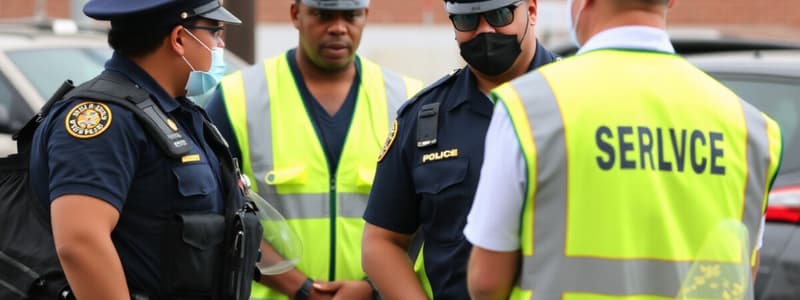Podcast
Questions and Answers
What is the primary focus of the course 'Police and the Community'?
What is the primary focus of the course 'Police and the Community'?
- The relationship between police and communities (correct)
- The role of police in criminal investigations
- Historical events in law enforcement
- Techniques for crime scene management
Which of the following is a prerequisite for the course CJUS1202?
Which of the following is a prerequisite for the course CJUS1202?
- Criminal Justice Theory
- Ethics in Law Enforcement
- Advanced Criminal Investigations
- Introduction to Criminal Justice (correct)
What is one of the key outcomes of the course regarding police-community relationships?
What is one of the key outcomes of the course regarding police-community relationships?
- To understand barriers to cooperative partnerships (correct)
- To develop tactical police responses to crime
- To analyze historical crime data
- To implement new policing technologies
What concept is emphasized in the course related to reducing crime?
What concept is emphasized in the course related to reducing crime?
Which of the following topics is NOT included in the content of Unit I?
Which of the following topics is NOT included in the content of Unit I?
How long is the course 'Police and the Community' in total contact hours?
How long is the course 'Police and the Community' in total contact hours?
What aspect of community dynamics will the course examine?
What aspect of community dynamics will the course examine?
Which outcome involves researching current practices in policing?
Which outcome involves researching current practices in policing?
What is one key aspect of community policing?
What is one key aspect of community policing?
Which group is NOT typically associated with community interaction in policing?
Which group is NOT typically associated with community interaction in policing?
What is a barrier to developing positive relationships between the police and the community?
What is a barrier to developing positive relationships between the police and the community?
What role do community meetings play in fostering a partnership with the police?
What role do community meetings play in fostering a partnership with the police?
Which of the following is an action necessary to address crime in communities?
Which of the following is an action necessary to address crime in communities?
Which factor does NOT influence a cooperative partnership between criminal justice agencies and the community?
Which factor does NOT influence a cooperative partnership between criminal justice agencies and the community?
What are community leaders expected to do in the context of police-community relationships?
What are community leaders expected to do in the context of police-community relationships?
What is one method of delivery used in the unit on Police Community Relations?
What is one method of delivery used in the unit on Police Community Relations?
How can barriers to a positive relationship between the police and community be addressed?
How can barriers to a positive relationship between the police and community be addressed?
What percentage of the final assessment is designated for the case study?
What percentage of the final assessment is designated for the case study?
Which of the following resources is specifically mentioned as an online resource?
Which of the following resources is specifically mentioned as an online resource?
Which of these learner outcomes is associated with the use of information communication technologies?
Which of these learner outcomes is associated with the use of information communication technologies?
What is the weight of the final examination in the overall assessment?
What is the weight of the final examination in the overall assessment?
What is a key action necessary to effectively address crime in communities?
What is a key action necessary to effectively address crime in communities?
Which of the following is important for maintaining a good police relationship with youth?
Which of the following is important for maintaining a good police relationship with youth?
What is one method to improve police relationships with the elderly?
What is one method to improve police relationships with the elderly?
Which of the following is NOT a characteristic of restorative justice?
Which of the following is NOT a characteristic of restorative justice?
What is an alternative dispute resolution strategy?
What is an alternative dispute resolution strategy?
Which action can help in developing a police and community relations plan?
Which action can help in developing a police and community relations plan?
What is an example of community justice?
What is an example of community justice?
What is the role of a good police-press relationship?
What is the role of a good police-press relationship?
Flashcards
Police Press Relationship
Police Press Relationship
Open communication and collaboration between law enforcement and the media.
Police Youth Relationship
Police Youth Relationship
Positive interactions between law enforcement and young people.
Police Relationship with Elderly and Special Needs
Police Relationship with Elderly and Special Needs
Tailored communication and support for vulnerable populations.
Restorative Justice
Restorative Justice
Signup and view all the flashcards
Community Justice
Community Justice
Signup and view all the flashcards
Alternative Dispute Resolution
Alternative Dispute Resolution
Signup and view all the flashcards
Mediation
Mediation
Signup and view all the flashcards
Negotiation
Negotiation
Signup and view all the flashcards
Community Policing
Community Policing
Signup and view all the flashcards
Empowering the Community
Empowering the Community
Signup and view all the flashcards
Successful Community Policing Programs
Successful Community Policing Programs
Signup and view all the flashcards
Ministry of Justice
Ministry of Justice
Signup and view all the flashcards
Barriers to Police-Community Partnership
Barriers to Police-Community Partnership
Signup and view all the flashcards
Professionalism and Ethics
Professionalism and Ethics
Signup and view all the flashcards
Charter of Rights and Human Rights
Charter of Rights and Human Rights
Signup and view all the flashcards
Use of Force
Use of Force
Signup and view all the flashcards
Concept of Community Justice
Concept of Community Justice
Signup and view all the flashcards
Positive Partnership (Police & Community)
Positive Partnership (Police & Community)
Signup and view all the flashcards
Police Role in the Community
Police Role in the Community
Signup and view all the flashcards
Barriers to Positive Partnership
Barriers to Positive Partnership
Signup and view all the flashcards
Community Justice Application
Community Justice Application
Signup and view all the flashcards
Police Community Relations
Police Community Relations
Signup and view all the flashcards
History of Police Community Relations Programs
History of Police Community Relations Programs
Signup and view all the flashcards
Formal & Informal Groups (Community)
Formal & Informal Groups (Community)
Signup and view all the flashcards
ICT in Policing
ICT in Policing
Signup and view all the flashcards
Police-Community Relations Plan
Police-Community Relations Plan
Signup and view all the flashcards
Research in Policing
Research in Policing
Signup and view all the flashcards
Case Study Analysis
Case Study Analysis
Signup and view all the flashcards
Guest Lecturers
Guest Lecturers
Signup and view all the flashcards
Study Notes
Course Information
- Course Name: Police and the Community
- Course Code: CJUS1202
- Credits: 3
- Contact Hours: 45 hours (theory)
- Pre-requisite(s): Introduction to Criminal Justice - CJUS1101
- Co-requisite(s): None
- Semester: Not specified
Course Description
- Examines the relationship between police and the communities they serve
- Discusses the history, philosophy, and contemporary approaches to crime reduction
- Explores community concerns and the internal/external barriers hindering collaboration
- Emphasizes utilizing criminal justice resources for community crime prevention
Course Outcomes
- Understand the concept of community justice
- Understand the importance of positive partnerships between criminal justice agencies and the community
- Understand the interrelationship between police and community
- Identify barriers to positive and cooperative partnerships
- Apply community justice concepts to all criminal justice system components
- Research and understand current trends in policing and community relations
Unit I: History of Law Enforcement and Community Relations Programs (8 hours)
- Explains the concept of police community relations
- Describes the history of law enforcement and community relations programs
- Identifies the role of the police in the community
- Recognizes formal and informal groups within communities (e.g., neighborhood watch, youth clubs, churches, community leaders, service clubs)
Unit II: Partnerships Between the Criminal Justice System and Community (8 hours)
- Evaluates the concept of community policing
- Identifies ways to foster positive partnerships between criminal justice agencies and the community
- Analyzes barriers to positive police-community relations
- Provides recommendations for removing barriers and building positive relationships
Unit III: Issues that Impact on Police Community Relations (10 hours)
- Identifies issues affecting positive police-community partnerships
- Discusses professional ethics (corruption), human rights, relationships with NGOs, lethal/non-lethal force, and perceptions of police by communities
- Describes actions for effective crime reduction in communities.
Unit IV: Police Community Relations with Specific Groups (8 hours)
- Explains the importance of positive police relationships with various groups (press, youth, elderly, special needs)
- Outlines methods for building positive relationships with specific groups
- Develops a comprehensive police and community relations plan
Unit V: Concepts of Community and Restorative Justice (8 hours)
- Explains concepts of community and restorative justice
- Demonstrates alternative dispute resolution strategies in community scenarios
Unit VI: Police Community Relations in the Technology Age (1 hour)
- Discusses how information communication technologies can improve police-community relationships
Methods of Delivery
- Lectures, discussions, case studies, projects, presentations, role-play, problem-solving, debates, research, YouTube videos, guest lectures, and seminars
Methods of Assessment and Evaluation
- Coursework (police and community relations plan, research/presentation, case study): 15%, 15%, and 10% respectively
- Final Examination (one compulsory case study): 60%
Resource Materials
- Provides recommended texts (David L.C., Hunter and Baker, M.D. White)
- Lists online resources (Ebscohost databases, Jamaica Constabulary Force, Ministry of Justice website, Interpol)
Studying That Suits You
Use AI to generate personalized quizzes and flashcards to suit your learning preferences.




